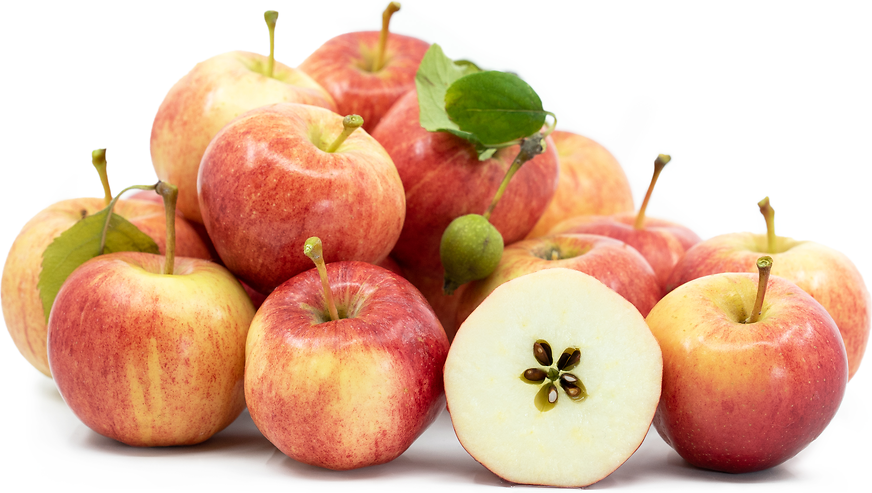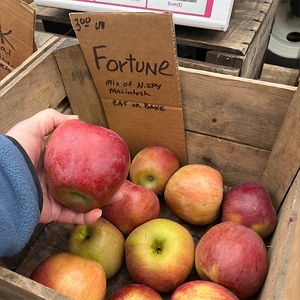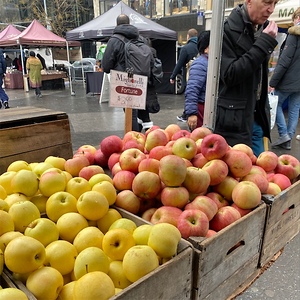


Fortune Apples
Estimated Inventory, lb : 0
Description/Taste
Fortune apples are a medium to large varietal that bears a fairly uniform, round to oblong shape. The apples have flat shoulders surrounding a short, fibrous green-brown stem, and the skin is smooth, matte, and semi-thick, developing a chewy consistency. The skin also has a yellow-green coloring, covered in a few yellow lenticels and large patches of burgundy to bright red-orange blush, striations, and striping. Underneath the surface, the ivory to yellow flesh is coarse, aqueous, and dense with a crisp, snap-like quality. The flesh also encases a central cavity filled with small and brown, tear-drop-shaped seeds. Fortune apples have an initially tart flavor followed by a subtle fruity sweetness with spice-filled, warm undertones. Some Fortune apples may also exhibit a slightly bitter taste surrounding the core. The strength of this trait is dependent on cultivation methods, climate, and terroir.
Seasons/Availability
Fortune apples are available in the mid-fall through winter.
Current Facts
Fortune apples, botanically classified as Malus domestica, are a biennial variety belonging to the Rosaceae family. The mid to late-season cultivar was developed in New York in the late 20th century and was selected as an improved modern commercial variety. Fortune apples are a dual-purpose cultivar suited for fresh market sales and processing. Apple enthusiasts favor the variety for its sweet-tart flavor, and the fruits can be consumed fresh, out of hand, or incorporated into an array of cooked preparations. It is important to note that Fortune apples are a distinct variety and should not be confused with Laxton’s Fortune, a cultivar in England, or Sister of Fortune apples, a close cousin of the Fortune variety.
Nutritional Value
Fortune apples are a source of potassium to balance fluid levels within the body and fiber to regulate the digestive tract. The apples also contain vitamin C to strengthen the immune system, vitamin A to maintain healthy organ functioning, vitamin E to protect the body against free radical damage, and lower amounts of magnesium, folate, iron, copper, calcium, and phosphorus.
Applications
Fortune apples are a multi-purpose variety well suited for fresh and cooked preparations. The apples can be consumed straight, out of hand, valued for their spice-filled flavor and large size, or the fruits can be chopped for slaws, tossed into salads, sliced and dipped in nut butter, or mixed into fruit bowls. Fortune apples are also slow to oxidize, used as a fresh topping over grain bowls, porridge, or waffles, dipped as a candied treat, or they can be blended into smoothies, pressed into juices, or thinly sliced and layered into sandwiches. In addition to raw preparations, Fortune apples can be incorporated into baked goods such as pies, tarts, cakes, muffins, and turnovers. The crisp apples also hold their shape well when baked into crumbles and crisps, stuffed with dried fruits and nuts and baked, or simmered into sauces, jams, and butter. Beyond sweet dishes, Fortune apples can be chopped and served with pork tenderloin, sauteed as a savory-sweet side dish, or finely chopped and mixed into stuffing. Fortune apples pair well with herbs such as parsley, mint, and rosemary, spices including nutmeg, cinnamon, ginger, and cloves, meats such as beef, pork, and turkey, celery, butternut squash, carrots, broccoli, and potatoes. Whole, unwashed Fortune apples will keep 1 to 4 months when stored in the refrigerator's crisper drawer.
Ethnic/Cultural Info
Fortune apples acquired their name from their original breed number. When the variety was being developed at the New York Agricultural Experiment Station, the apples were labeled as New York 429 or NY429. This number was used among growers who were testing and trialing the variety, and throughout the thirty-three years of testing, the apples were one of the few varieties to be frequently requested by growers before their commercial release. This widespread recognition before their commercial introduction created a buzz around the variety, and many growers and distributors began predicting the variety’s success. Growers also commented that the variety’s numerical sound of 429 sounded like “fortune,” and it was eventually determined that the name Fortune was a representative label for the commercial version.
Geography/History
Fortune apples were developed in 1962 at Cornell University’s New York State Agricultural Experiment Station in Geneva, New York. The station is one of the most famous breeding facilities in North America and has released over 224 fruit varieties since its establishment, 63 of the introductions being successful apple cultivars. Fortune apples were crossbred between schoharie spy apples, a red sport of northern spy, and empire apples. Roger Way, Susan Brown, David Terry, and Kenneth Livermore were the primary breeders, and the variety was tested for thirty-three years before it was released to commercial markets in 1995. Fortune apples were first debuted as a commercial cultivar at the New York State Horticultural Show in Rochester, New York. Today Fortune apples are cultivated through licensed growers in partnership with the Agricultural Experiment Station, and the fruits are sold through farm stands, local markets, and distributors in North America and England. The variety is also one of the nineteen apples to be marketed by the New York Apple Association.
Recipe Ideas
Recipes that include Fortune Apples. One
| Foodista |
|
Lentils and Apples with Acorn Squash |









